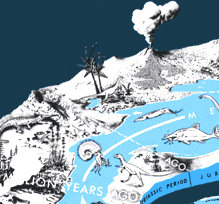
 see the geologic time scale
see the geologic time scale

 see the geologic time scale
see the geologic time scaleThe Earth is very old -- 4.5 billion years or more according to recent estimates. Most of the evidence for an ancient Earth is contained in the rocks that form the Earth's crust. The rock layers themselves -- like pages in a long and complicated history -- record the surface-shaping events of the past, and buried within them are traces of life --the plants and animals that evolved from organic structures that existed perhaps 3.9 billion years ago.
see geologic timeline since the earth was formed 4.55 billion years BP
Also contained in rocks that were in a molten state when the earth was formed, are radioactive elements whose isotopes provide us with an atomic clock. Within these rocks, "parent" isotopes decay at a predictable rate; this is defined as the time elapsed when half of the parent isotope has decayed to form "daughter" isotopes. By determining the relative amounts of parent and daughter isotopes, the age of these rocks since they were formed (i.e. were in molten state) can be calculated.
Thus, the results of studies of rock layers (stratigraphy), of fossils (paleontology), coupled with the age of certain rocks as measured by atomic clocks (geochronology), attest to a very old Earth!